About two months ago this painting drew me in. I wanted to know more but didn’t think about it too much. I wanted to take a closer look.
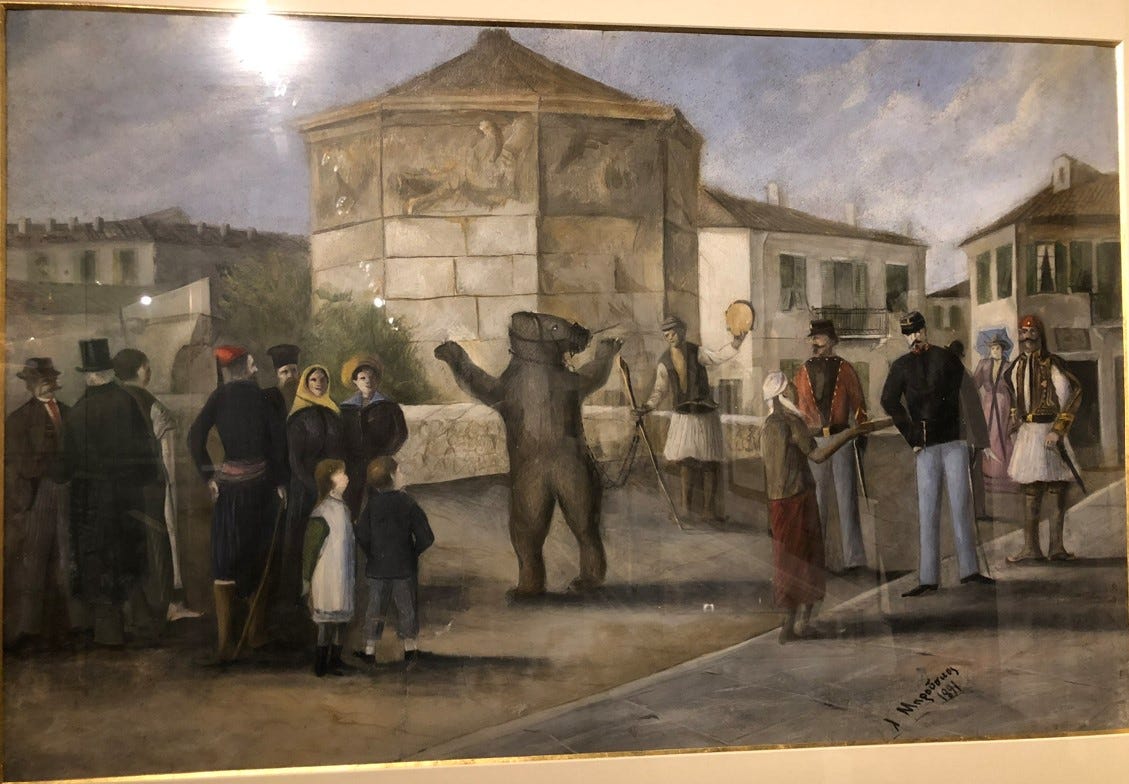
First of all, there’s a dancing bear at the heart of this painting. The bear is the focal point. There are also sixteen people surrounding the dancing bear.
Their postures, their garb, their expressions and where they are directing their attention reveal them to be an eclectic group. Not a group I’d typically imagine to gather in a square in 1891 Athens, but I don’t know much about Athens in 1891. Yet I’m more curious looking at this painting.
The dancing bear at the heart of the painting is more intuitively understandable and makes more sense than anyone else in the painting, except for possibly the two curious children watching the bear without any distraction.1
That’s two out of sixteen people fitting in. One-eighth of the scene. Some adults are watching, but they are wearing strange clothes or the bear is distracting their attention. What’s going on with the other fourteen people!?
The second two most functionally obvious people are the two guys who are working along with with the bear. One man appears to be both controlling and manipulating the bear, possibly playing music with a tambourine while simultaneously restraining the bear’s muzzle with a chain on his right wrist and a spear in the same hand. The bear must be either extremely well tamed, really into the music, or semi-tranquilized. A chain connected to a bracelet around this man’s wrist doesn’t seem like enough restraint for large bear. The man holds a spear in the same hand. My guess is the bear has been tamed by cruel, spear-inflicted torture and has been conditioned by trauma. Given the widespread cruelty, fighting, submission, and power struggles going on at this period among the Hellenistic population, after the centuries-long Ottoman occupation and amid a period of infighting and turbulence, this treatment of animals probably felt quite natural. Wild animals and circus animals have also been treated badly since, well forever. I doubt the bear is that into the tambourine.2
It’s a pretty big bear, also. Probably not a grizzly (confined to the American continent and doubtfully trafficked except as fur or hide) but a brown bear (ursos arctos, indigenous to Eurasia). This is still a large and powerful mammal many times stronger than the strongest human beings.
The dancing bear focal point incidentally brings out the personalities of everyone surrounding him. Out of those personalities, the context and character of the time emerges. I think that is why I like this painting so much.
Athens in 1891 seems a strange and cryptic time and place. A time of transition and freedom amid a peculiar running-in-place, from ethnic and religious disagreements to political indecision on who should rule the sovereign, yet disorganized peninsula. I’ll get into this in the next four paragraphs.
Let’s look at the other man working alongside the bear. This man appears to be asking for money. At second glance, he also appears poor. His clothes are plain and his head scarf raggedy, almost like a loose-fitting durag—which raises the question whether this head-covering/substitute-hairstyle is indeed rooted in Muslim cultures, recalling how Amiri Baraka and Malcolm X drew connected modern Black America to Islamic ethnic groups and nationalities in northern Africa and the Near East. This man’s unique head-covering can be seen as a false anachronism—blurry through time and transcription, whether you spell it do-rag or dew-rag, or head-scarf or whatever it is, whether you trace its rise to the 1990s, the 1960s, the 1930s—or, the 1890s, or earlier.
Regardless, this man appears to be the beggar asking for contribution for the dancing bear. Yet I could be projecting modern sensibilities to the past. His skin appears to be darker than anyone else’s skin in the painting, except for maybe the formally-attired man in the red hat looking directly at him. It’s hard to tell with the way of the light and the shadows—it’s only apparent that it’s dusk.
This period was also dusk for the Ottoman Empire, and post-dusk for the Ottoman occupation of the Greece. After the Greek War of Independence in 1821, the Greeks proclaimed First Hellenic Republic in 1822. Things didn’t go smoothly, though. Infighting and civil wars broke out, then Ottoman Turks with Egyptian aid recaptured Athens in 1827. A Holy War prompted Russian troops to get involved, while Greeks continued to defy their own organizing attempts at state-building. Britain, France and Russia assigned a monarch to Greece, the Bavarian Prince Otto. The Bavarian Prince ruled with Bavarian influence (Fix, or Φιξ beer was founded in 1864). Otto was dethroned in 1862. Throughout the rest of the century the Russo-Turkish War (which generated countless paintings in its 350-year stretch) guaranteed instability. Greeks continued to try to seize Turkish territory, the Ottoman Turks likewise tried to seize Greek territory—well through the 1890s, including but not limited to Athens.3
All this is to say that the present moment in 1891 was complicated. The relationship and skin color of the durag-wearing man and the formally-attired man looking at him might not mean much, except that one was powerful and the other one not. In the centuries leading up to this painting there were many factions—mostly religious and ethnic. Not just Greek or Turkish and black or white, but Turkish-Muslim, Greek-Muslim, Orthodox Christian, non-Orthodox Christian, crypto-Christian (feigning devotion to another faith while secretly adhering to Christianity), and many things in between. Political beliefs seemed to matter, but not as much as religious or ethnic or national identity. The Frankocrats and the Turkocrats had been staved away (after about a millennium-long occupation) but powers of influence remained over the Greek peninsula. A British-French-Russian alliance often intervened through the 19th century until the end of World War I to stave of invasions in the name of Christendom (against Islam), probably enabling and emboldening the myth of “the West” as warring Christian factions gradually unified, adopting some of each other’s stories and myths.
Which leads me to three more figures: the three mustachioed officials in mismatched uniforms. They all have a common moustache. They all are armed with sabers. The two men on the left also share similar beards, similar hats, and similar trousers. Perhaps these two men are different ranks but part of the same group. Based on brief looks at modern Greek soldier uniforms, the men are likely different ranks of the Greek military or defense unit. The man in the skirt-like uniform is actually wearing a uniform identical to uniform worn today, by the Greek Presidential Guard (Evzones) uniform. As I write this, anyone can observe soldiers wearing this uniform in front of the Presidential Mansion or in front of the Tomb of the Unknown Soldier, both near the National Garden in downtown Athens (across the street from the Benaki Museum4 where this painting lives)—
Two figures stand behind the soldiers: a woman in a purple gown and hat, holding a blue umbrella. There’s also a hidden man in a top hat. I doubt these figures are that special to think about, although they do appear a higher class than the people on the other side of the bear. Could they be nobility? If indeed the three men standing in front of them are Greek Presidential Guard, then these concealed people might be more important than the painting leads us to believe.
Let’s switch to the other side of the bear, where the family stands.
The children observe the bear with childlike curiosity and the parents also look on amusingly. The man wears a yellow hat and some kind of blue collar or scarf. The woman, presumably his wife, wears a yellow head scarf. This family doesn’t stand out too much except for the fact they are an ordinary, happy nuclear family. That’s saying something. Nations are built on families, after all. The woman wears a head scarf and the man a hat. I’m not sure if this indicates some traditionalism, maybe even religious affiliation? It could simply be the styles at this time.
Of the two men behind them, one appears to be of an institutional religious rank. The black, cylindrical hat is the hat worn by Orthodox Christians. It’s called a kalimavkion. This indicates he is clergy or a priest. This man’s body is mostly concealed, but he also appears to have a long beard, also common among Orthodox Christians. The man in the red hat with a tassel and his back to the painter appears also to be in some kind of uniform. One with a loose-fitting bottom and a belt. He is talking to the priest, who is looking at the bear (somewhat suspiciously). This man is also taller than the priest and also bearded. I suppose he might have some authority over the priest, who isn’t totally listening to him. There could be a subtle commentary here about the religious orders and conflicts at the time.
And then there’s these men:
Bureaucrats? Are they British, French or Russian?
We can’t see the man in the middle but he is also wearing a stiff, black cylindrical hat. This hat has a brim and does not have a wider circle on top. This is a top hat, or a stovepipe hat (or an opera hat), fashionable at the time, but not apparently a popular fashion accessory for Greeks. It calls to mind high society or a diplomatic and presidential class. Like Abraham Lincoln, or Daniel Day-Lewis’s Bill the Butcher in Gangs of New York. Apparently also Winston Churchill in 1912. The man who Mr. Top Hat is talking to also appears to have very non-Greek accoutrements: bifocals, red tie, starched collar, dress coat and vest, shaggy mustache, pin-striped trousers, and—I don’t know the name—but “detective” hat. I guess these men are British and they are in Athens as some sort of colonial overseers. This would have been high time for British expansion and occupation. The British controlled Egypt, the Ionian Islands, Cyprus, Palestine and Transjordan, all at some point in its heightening influence throughout the nineteenth century up through World War I.
There’s one more man painted in between these two apparent British colonialists. He faces away from them watching the bear. It’s anyone’s guess what this man’s role is. I predict the painter wanted one nondescript, ordinary person to throw in the mix, possibly some neutral body directing their attention at the bear so that the viewer could subconsciously project a line of their own attention without any bias or distraction towards the bear.
And one last look at the star of the painting.
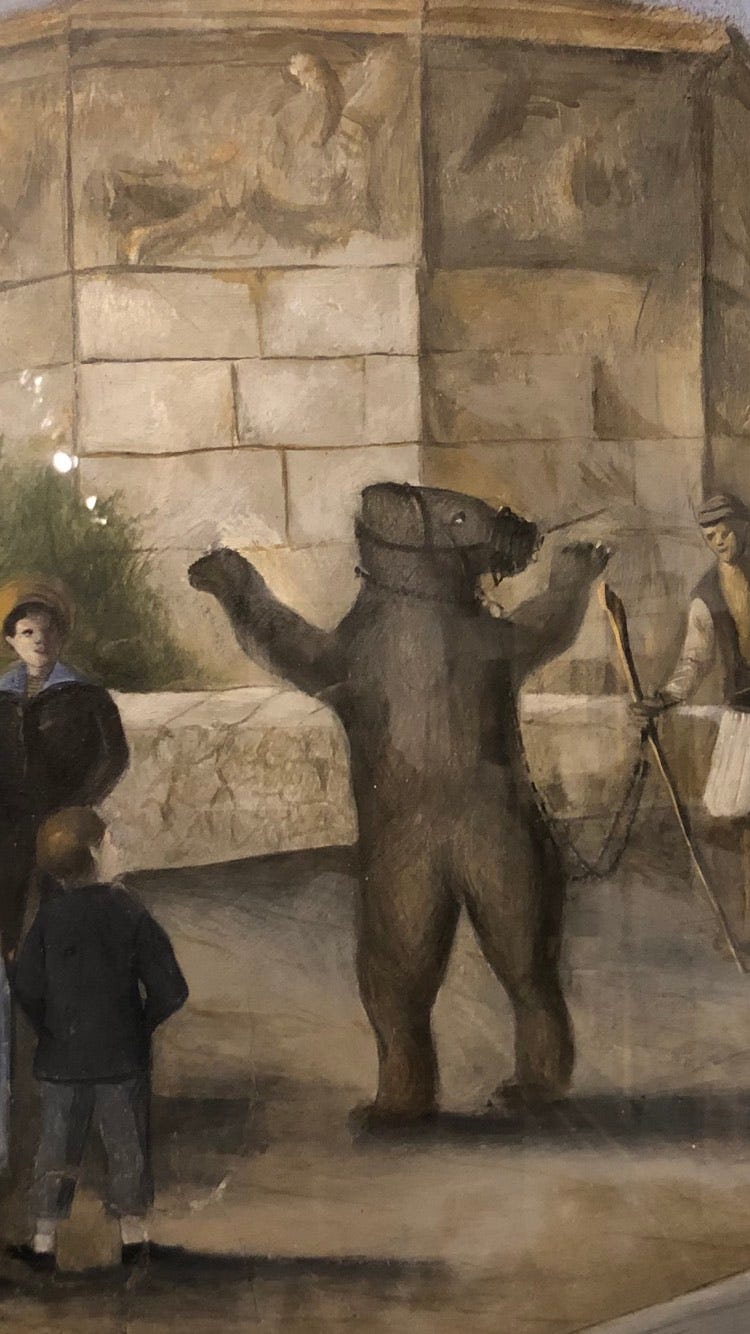
The bear. But this bear. This poor, muzzled bear, so awkwardly painted seems like she could break through those chains. This bear is a spectacle, mere secular entertainment, and that is all.
Down the esoteric “rabbit hole,” er um, “bear den” let’s compare it to Russian painter Ivan Shishkin’s bears, painted sometime between 1886 and 1889.
Shishkin’s bears are playful, untamed, freely exploring nature in their own terms. They are a family, the mama bear and her cubs. The painter is depicting a scene in Russia in a way I doubt many—if any—Greek painters at the same time were depicting scenes in Greece. This could be due that most or all bears in Greece might have been extinct by that time, due to ongoing wars. Yet, the California grizzly went extinct in 1924 and like the Russian brown bear, has lived on through myth, story and image in its own unique way.
Yet activists in the American west, from the Rockies to California, have focused on preserving habitats and grizzlies and even are suggesting reintroducing grizzlies, imitating the (apparent) success and (politicized) debate surrounding the reintroduction of wolves into Yellowstone in the 1995, in a way that’d be unimaginable in a place like Greece today. The point is, if we look at animal-human relationships in history, with sources not limited to but including how those animals are portrayed in art, it can open a window into the soul of the artists and thus the soul of the culture—how the artist and the culture see and represent things, relationships, human and animal lives.
I acknowledge I have hardly any sources to cite for this whole essay, so I’ll conclude by giving this thought legibility. I spent a lot of time researching the democratic movements in South Korea in the 1970s and 1980s, prior to the rise of the “tiger economy.” I also archivally researched the tracking and tagging of grizzlies in Yellowstone in the 1950s and 1960s. The intersection of my recent historical interests rests somewhere between nation-building and animal roles.
With this in mind, the role of the bear in the development of culture in both Russia and Greece, as seen in paintings from the late nineteenth century, differs. Animals can become integral to the lore of nation-building. Bears, for Russians, have come to represent many things. Not only is the Eurasian brown bear (ursos arctos) the Russian national animal, but it plays a role in many of its myths, stories, songs, images, &c. In Greece, the national animal is the dolphin, which is no surprise for a Mediterranean, mostly-coastal, island-saturated nation which also has sourced the words “isthmus” and “archipelago.” It is a nation of the sea. Other animals surely play roles in the lore of Greek identity, carried over from older ancient myths: Athena’s owls, for example. What also comes to mind are the countless hybrid creatures of pre-Christian myths: chimera, sphinx, medusa, minotaur, centaur, hydra, hippocamp, echidna, &c.
Representation of Bears in Late Nineteenth Century Art
There might be something interesting to look at there. The many roles animals play in art and culture-building can reveal things about a culture. It’s sad to see that this dancing bear in Athens appear more like a bear-in-captivity, but closer to real in representing the nature-culture divide in the globalized world today even as environmental consciousness appears to be on the rise.
Where I used to live in Montana, it was not difficult to see animal and landscape inspired art every day. Local artists painted these things a lot, and there was such an abundance of this type of art that I honestly got sick and tired of seeing it. It’s often done very well, with lots of color, creativity, and skill—mixing genres and taking a lot of influence from Native American and indigenous tribal art.
Yet it often fails to communicate anything human. What about our relationship, as humans, to that animal, and what about that animal’s relationship to us? What about the interaction, the human-animal, transspecies relationship? Nature and landscape art often lacks that spirit. I’m not jut talking about cowboys riding horses rounding up cattle. That’s been played out.
The human-animal relationship can be cruel and kind. It can be mystical and it can be pragmatic, infusing spirit into the animal or removing its soul—dehumanizing it. This is to say, anthropomorphizing may beget connecting with and understanding an animal’s spirit, to some degree. Alas, this is a better fate than caging pigs, cows and chickens, or taming bears to dance.
Anyway. One painting contains a lot.
2,765 words. If you let it.
Thank you for reading, and hope to see you in a week.
Any major square in almost any major city has its own unique mix of entertainers, which change over time depending on trends of what people will stay to see and listen to, what the city allows, and whose available to entertain.
The tambourine, an instrument which made its ways to Greece by way of Ancient Egypt and the near east (Turkey), with etymological roots in Middle Persian, tambūr or tabir, meaning drum. (OED and Wikipeidia)
I admit this is an abridged history mostly derived from the 2021 version of Lonely Planet: Greece. The point is, the 1800s in Athens were probably turbulent, disorganized, and diverse.
The Benaki Museum is housed in a mansion in downtown Athens, Greece, established and endowed in 1930 by Antonis Benakis in memory of his father Emmanuel Benakis and hosts a range of art from prehistorical to modern and periodic exhibitions. Benaki Museum - Home




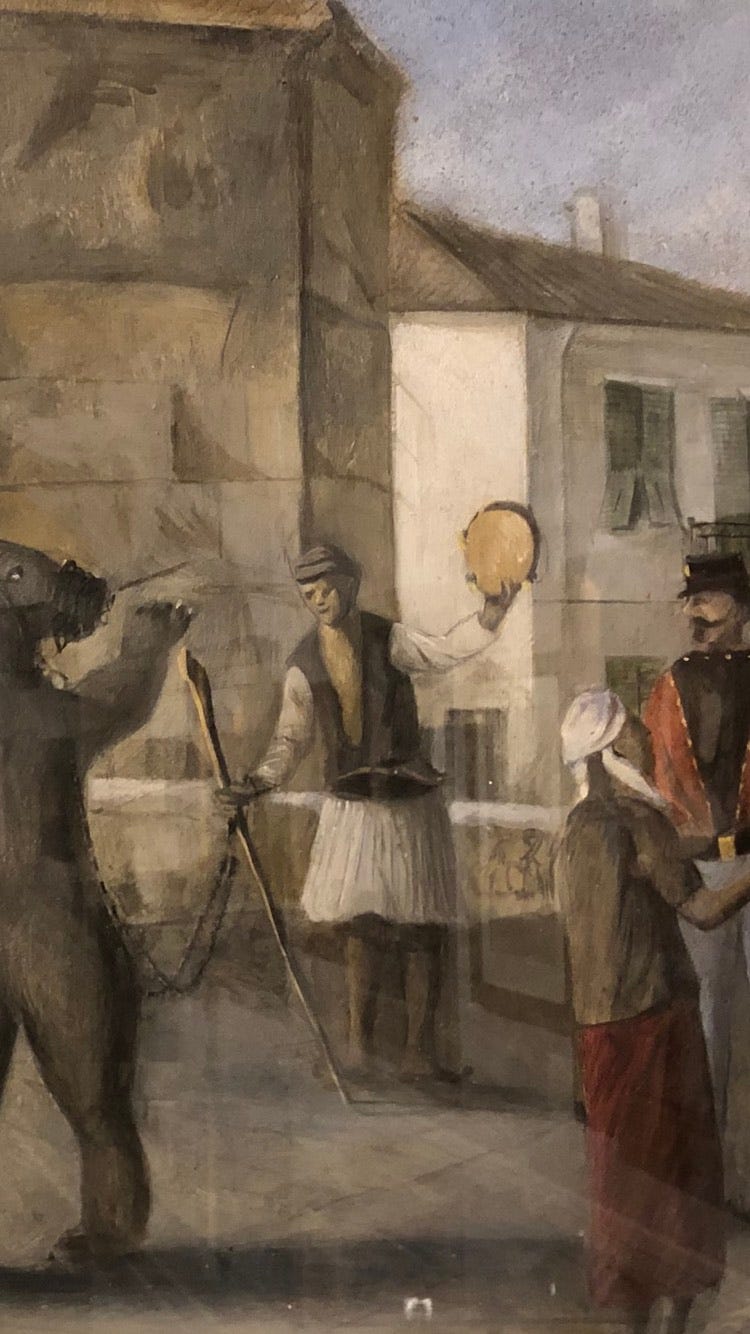

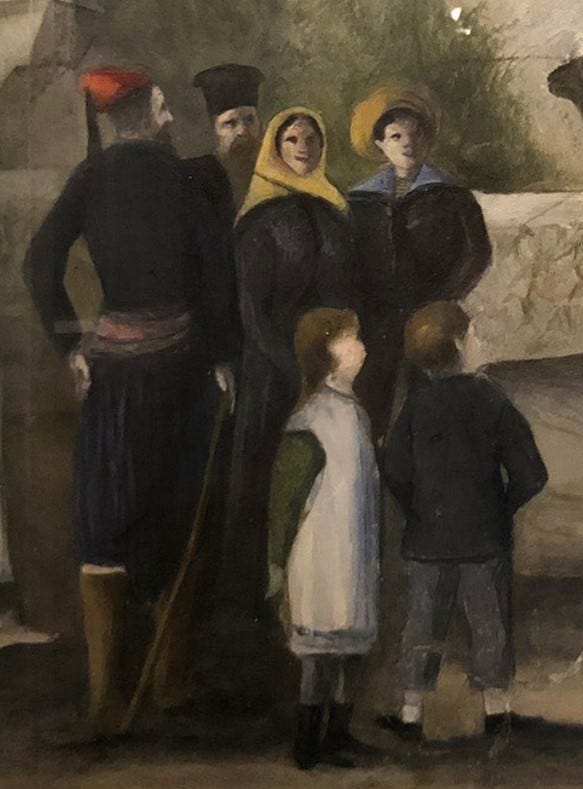

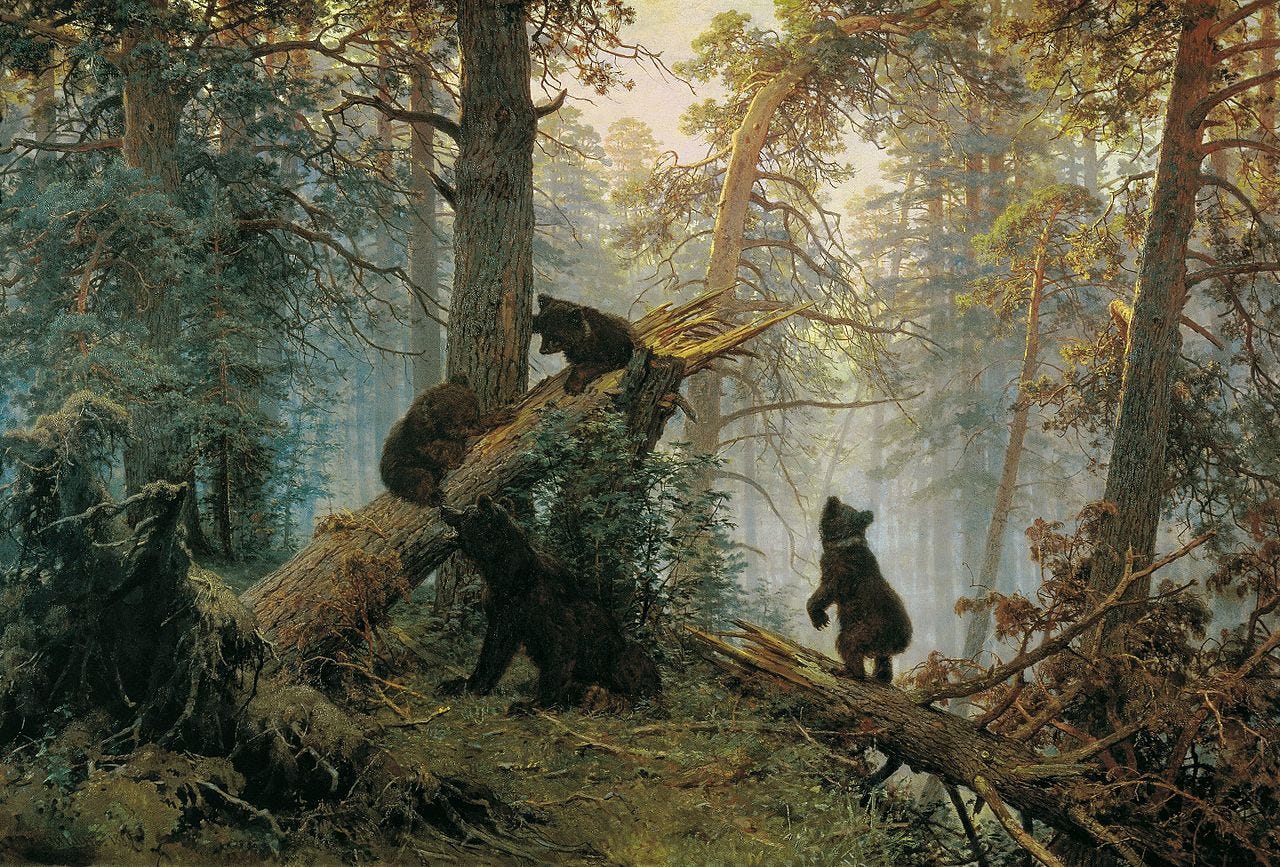
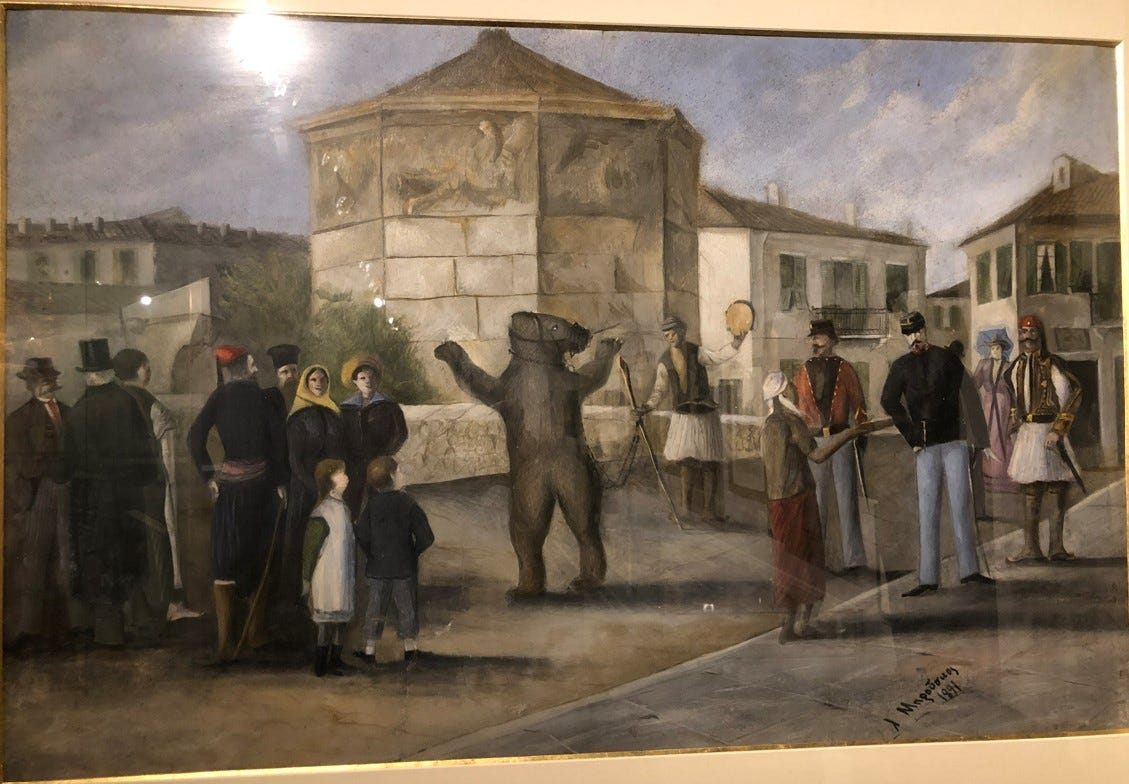

Hey, thanks for sharing :)